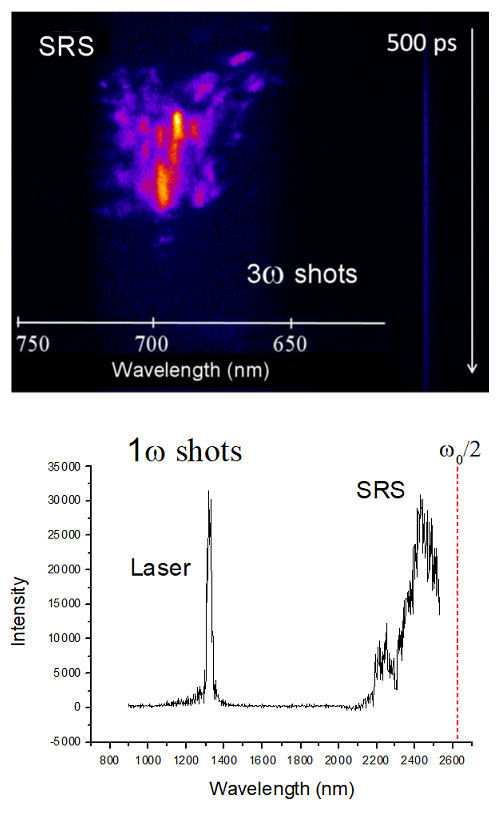Introduction and goals of the project
The project, funded by Eurofusion (European Consortium for the Development of Fusion Energy), began in spring 2021 and will end in 2024. It is the natural continuation of two previous projects carried out in 2017-2018 and 2019-2020, and aims at realizing a European research program on Shock Ignition (SI), a promising approach to Inertial Confinement Fusion proposed by R. Betti. SI is based on the separation of the compression phase of the thermonuclear target from the ignition phase, which is realized by a high-intensity laser beam (up to 1016 W/cm2 in a spike of several hundreds picoseconds). The feasibility of SI relies on the capacity of such spike to produce a very strong converging shock (at least 300 Mbar at the ablation front). Being substantially compatible with present-day laser technology (used to build NIF and and LMJ), SI could be tested within the next decade.

Time-resolved SRS spectrum from 3w irradiation and SRS spectrum from 1w irradiation, recently acquired at PALS facility
The beginning of operation of the LMJ/PETAL laser facility and its academic opening to Civilian Research done by European Academic groups opens, for the first time, the possibility of performing “inertial fusion experiments” at full-scale in Europe.
In addition to exploit this possibility, the participants to this project will perform experiments in Europe at Prague Asterix Laser System (PALS), at Shen Guang II and III in China and at the laser facility Omega at the University of Rochester, with the goal of both answering some open physical questions related to SI and consolidating a European research community directly working on inertial fusion experiments with big lasers. Other planned experiments, coordinated by the ILIL laboratory, will be carried on at Vulcan / CLF laser and at GEKKO XII laser in Osaka.
The project is organized in five Work Packages, each including experiments and theory:
• WP1: characterization of hot electrons and hot-electron-driven SI;
• WP2: hydrodynamic instabilities and mitigation strategies in DD-SI, including use of foams;
• WP3: bipolar SI: direct drive compression and bipolar spike irradiation;
• WP4: parametric instabilities and cross beam energy transfer, and their mitigation using broadband lasers;
• WP5: magnetic-field-assisted inertial fusion implosion and ignition.
The aim of the project is answering key physics issues on SI and DD,
consolidating the European community doing DD research, with the longer-term objective of designing and performing SI demonstration on NIF or LMJ.
The role of ILIL research group
The group, previously involved in the European HiPER project, has proven skills in the experimental study of laser solid interactions and, in particular, has significant expertise in characterizing laser plasma interaction mechanisms. In this project, the ILIL group contributes to experimental campaigns, often coordinating the experiments with Principal Investigators. Its work includes both the characterization of hot electron (including GEANT Montecarlo simulations) and, overall, the investigation of parametric instabilities. In SI interaction regime, in fact, the role of Stimulated Brillouin Scattering (SBS), Stimulated Raman Scattering (SRS) and Two Plasmon Decay (TPD) is central both for the significantly degraded laser-plasma coupling due to a strong reflection of light (SBS and SRS), and for the generation of hot electrons (SRS and TPD), which may preheat the fuel or affect the shock pressure. For this expertise, the INO unit will coordinate the WP4, focussed to the investigation of parametric instabilities.
The team
The project leader is D.Batani (Centre Laser Intense and Apllications, CELIA). The team is composed by several research groups widespread across Europe, including both theoretical and experimental expertise, which have already contributed to research on Shock Ignition. Many of such groups were already in the European HiPER project, dedicated to demonstrating laser driven fusion as a future energy source. The research groups involved are:
- CELIA, Université de Bordeaux, Talence – Group Leader: Dimitri Batani
- Our ILIL-INO laboratory from Pisa. The responsible of the research unit is G.Cristoforetti.
- PIIM, Université de Marseille, Marseille – Group Leader: Sandrine Ferri
- LULI, Ecole Polytechnique, Palaiseau – Group Leader: Bruno Albertazzi
- University of Rome “La Sapienza”, Rome – Group Leader: Stefano Atzeni
- Politecnico di Milano, Milano – Group Leader: Matteo Passoni
- Università di Milano Bicocca, Milano – Group Leader: Massimo Nocente
- ENEA – Centro Ricerche Frascati – Group Leader: Mattia Cipriani
- Universidad de Las Palmas de Gran Canaria (ULPGC) – Group Leader: Ricardo Florido
- USAL Salamanca – Group Leader: Luca Volpe
- Polytechnic University of Madrid – Group Leader: Javier Honrubia
- University of Valladolid – Group Leader: Marco Gigosos
- Instituto Fusión Nuclear “Guillermo Velarde” – Group Leader: Antonio Rivera
- Czech Technical University, Prague – Group Leader: Jiri Limpouch
- PALS, IPP.CR, Prague – Group Leader: Oldrich Renner
- University of York – Group Leader: Nigel Woolsey
- Central Laser Facility, Rutherford Appleton Laboratory – Group Leader: Robbie Scott
- Imperial College, London – Group Leader: Jeremy Chittenden
- University of Warwick – Group Leader: Tony Arber
- University of Strathclyde – Group Leader: Zheng-Ming Sheng
- Queen’s University Belfast , Group Leader: Daniele Margarone
- Wigner RCP, Budapest – group leader: István Földes
- IPPLM, Warsaw – Group Leader: Tadeusz Pisarczyk
- IST, Lisbon, Portugal – Group Leader: Marta Fajardo
- Hellenic Mediterranean University of Crete – Group Leader: Michael Tatarakis
- Kharkov Institute of Physics & Technology – Group Leader: Vasyl Maslov

